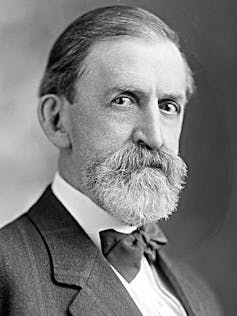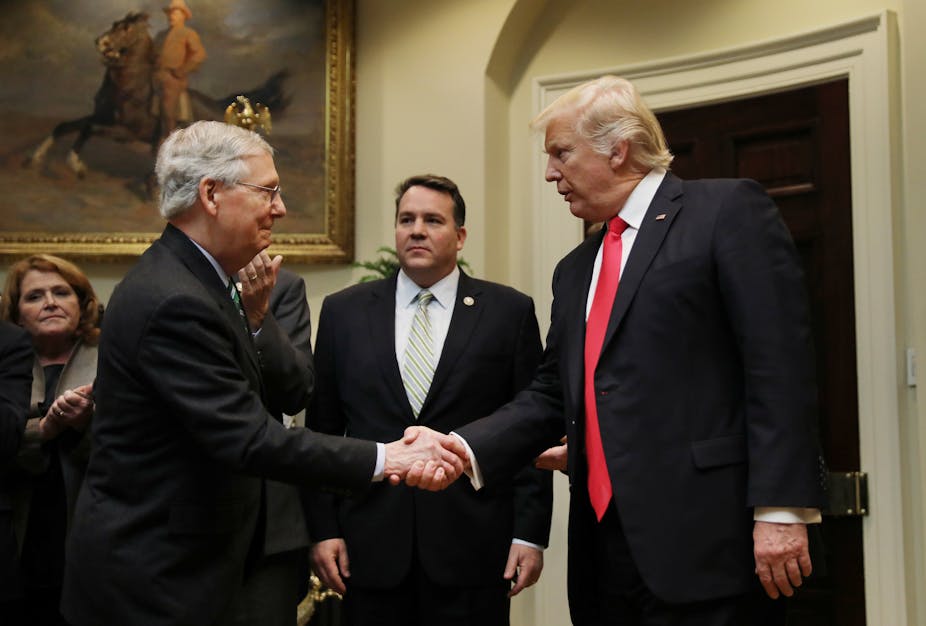Being Senate majority leader isn’t easy. And Mitch McConnell is finding out that having unified government could make it harder still.
As my research shows, U.S. Senate majority leaders represent several constituencies that push and pull in multiple – and usually conflicting – directions.
Balancing constraints
First, the leader is a senator responsible for representing the interests of his state – in McConnell’s case, Kentucky.
Second, like all majority leaders, McConnell is the leader of his party in the Senate, with an obligation to get more Republicans elected to office and to push a legislative agenda that burnishes the party label.
Third, as leader of the Senate, his duty is to sustain the institutional health of that chamber in its function as a counterweight to the whims of the House of Representatives, the ambitions of the executive branch and even the rulings of the judiciary.
Balancing the demands of the office’s various constituencies is sometimes further complicated by another demand on the Senate majority leader – the president, who in times of unified government becomes a fourth constituency to which the leader must answer.
Of course, that’s the position McConnell finds himself in with Donald Trump.
To understand why McConnell must answer to the president, it helps to know some history.
It started with Wilson
Unlike the speaker of the House, the U.S. Senate majority leader is not a constitutional office. Its functions were originally assumed to be the purview of the president of the Senate, a role played by the vice president, or in his absence, a senator acting as the president pro tempore.

That arrangement proved unsatisfactory to President Woodrow Wilson. Before entering politics, Wilson was an academic – a political scientist whose research advocated for parliamentary government. He became a president interested in legislating. Separation of powers meant that Wilson needed an advocate in the Senate to advance his plans for a “New Freedom,” as he called his program of progressive reforms. Senator John W. Kern, a Democrat from Indiana, became his willing partner, having proven himself a stalwart on progressive policy in his first two years in the Senate. In 1913, Kern – with the support of Wilson and progressives in the Democratic Party – won a contested leadership election in the Senate and was the first senator to be called “majority leader.”
The relationship between president and Senate majority leader was so close that in the secrecy of night Kern would walk from the Capitol to the White House to meet with Wilson to discuss legislative strategy. As majority leader, Kern became Wilson’s man in the Senate, managing the president’s agenda in committee and on the floor. He set a precedent that has continued for his successors – particularly when the same party controls the Senate and the White House.
Crazy like a fox
From this perspective, McConnell’s actions on health care are an entirely predictable strategy to meet the demands of his party and his president.
To repeal and replace the Affordable Care Act (“Obamacare”) has been the goal of congressional Republicans since before the law was passed. Among rank-and-file members of the GOP, it was a key factor in energizing a grassroots movement – the Tea Party – that delivered divided government for the final six years of the Obama administration. In that time, the Republican-led House voted more than 60 times to overturn the law. It’s no surprise, then, that Donald Trump found opposition to Obamacare fodder on the 2016 campaign trail and adopted Republican calls to repeal and replace the program.
Unlike Wilson, however, Trump shows no appetite for the minutia of crafting policy or the legislative process. Rather than leading with a specific health policy of his own, the president left it to his congressional Republicans to fulfill his promise to repeal and replace Obamacare.
Speaker Paul Ryan used his solid, but not overwhelming, majority to deliver a House bill. The burden then fell on McConnell to deliver for the Senate. A bill designed by 13 male senators working in secret failed to pass even the motion to proceed – twice. Apparently, without a substitute plan, McConnell then proposed a vote on repeal only, reserving a replacement for a future Congress. On this, too, his party is fractured. Three senators – Shelley Moore Capito of West Virginia, Susan Collins of Maine and Lisa Murkowski of Alaska – have said they won’t support the bill. That’s enough to keep it from even being debated.
Why call the vote?
But McConnell is not caving to the numbers. He intends to call a vote on a version of the healthcare legislation anyway.
Why? McConnell is attempting to balance the multiple constituencies of his office.
Trump has pledged to repeal and replace Obamacare. Despite – or perhaps because of – his hands-off approach to policymaking, he expects his Senate majority leader to work the legislative process to fulfill that promise. In calling for a vote – even one presumably destined to fail – McConnell serves as the president’s dutiful lieutenant, following orders even with no anticipation of victory.
He’s serving his party’s interests as well. Except for the few defectors among Republicans in the Senate, the party remains unified in its aim to roll back the signature piece of legislation from the Obama presidency. “Repeal and replace” has been the mantra of the past four elections that ushered many of the current members of Congress into office. The point of calling a failed vote is to establish a record of performance for those Republicans who vote for the repeal and especially for those who do not.
Political scientist David Mayhew described position-taking by members of Congress in which voting forces them to go on record and commit to an issue position. Often this strategy is used against the opposing party. Here, McConnell’s insistence on a vote to repeal Obamacare is a coercive tactic against members of his own party. It can be viewed only, I would argue, as a precursor to a purge, an attempt to identify those Republicans who, despite years of riding the repeal bandwagon, ultimately can’t bring themselves to abolish an established and popular entitlement program. The vote stands to be an ideological purifier that likely strengthens those who vote for repeal and ensures a primary challenge for those who do not.
But McConnell no doubt has his first constituency – the state of Kentucky – in mind as well. I’ve examined those rare instances when Senate majority leaders lose their seats. Here again the origins of the office are significant to the way it works today. That is, a majority leader’s electability is strongly tied to his relationship with the president.
Consider the examples of Tom Daschle and Harry Reid. As Senate majority leader from 2001 to 2003 and thus the highest-ranking Democrat, Daschle was forced to lead the opposition against President George W. Bush, who won Daschle’s home state of South Dakota with 60 percent of the vote.
On the flip side, Harry Reid found himself in a tough race in 2010. But as Senate majority leader, he had the advantage of serving a Democratic president who was popular in his state. Barack Obama won Nevada by a 12.5 percent margin over Republican John McCain in 2008. Being the president’s man wasn’t the only reason Reid won, but it was a factor in his victory against a Tea Party wave.
Donald Trump won Kentucky in 2016 with 62.5 percent of the vote, a margin of nearly 30 percent over Hillary Clinton and an increase of 8 percent over the Democratic nominee from 2012. As long as Trump remains popular in Kentucky and among Republicans, McConnell will find it possible to balance his multiple constituencies by being the president’s man in the Senate.

